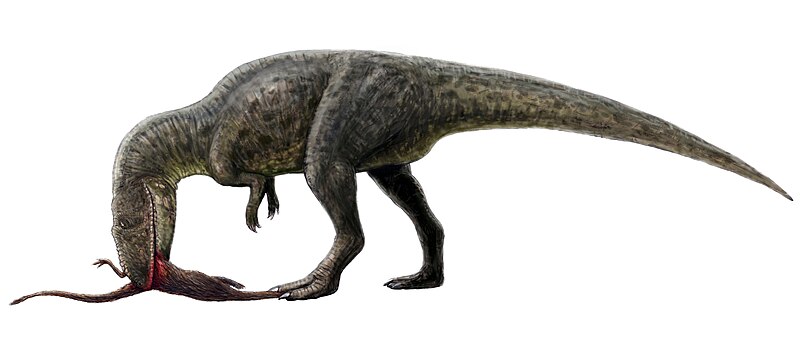Post by dinosauria101 on Apr 19, 2019 14:57:30 GMT 5
Deinonychus antirrhopus (pack of 3)
Based on the few fully mature specimens, Deinonychus could reach 4 metres (13 ft) in length, with a a weight of 100 kg (220 lb). Its skull was equipped with powerful jaws lined with around sixty curved, blade-like teeth. Studies of the skull have progressed a great deal over the decades. Ostrom reconstructed the partial, imperfectly preserved, skulls that he had as triangular, broad, and fairly similar to Allosaurus. Additional Deinonychus skull material and closely related species found with good 3D preservation show that the palate was more vaulted than Ostrom thought, making the snout far narrower, while the jugals flared broadly, giving greater stereoscopic vision. The skull of Deinonychus was different from that of Velociraptor, however, in that it had a more robust skull roof like that of Dromaeosaurus, and did not have the depressed nasals of Velociraptor. Both the skull and the lower jaw had fenestrae (skull openings) which reduced the weight of the skull. In Deinonychus, the antorbital fenestra, a skull opening between the eye and nostril, was particularly large.

Shaochilong maortuensis
Shaochilong (meaning "shark toothed dragon") is a genus of carcharodontosaurid dinosaur from the mid Cretaceous (Turonian stage) Ulansuhai Formation of China (about 92 million years ago). The type species, S. maortuensis, was originally named Chilantaisaurus maortuensis, but was re-described and reclassified in 2009. The holotype, IVPP V2885.1-7, consisting of skull fragments, axis and six caudal vertebrae associated to a single individual is the only known specimen. This specimen was discovered in Outer Mongolia and described by Hu in 1964 as a species of Chilantaisaurus. Chure (2002) and Rauhut (2001) suggested that it did not belong to that genus, and was probably a primitive coelurosaur. However, a re-description by Brusatte and colleagues in 2009 found that it was in fact a carcharodontosaurid, the first recognized from Asia. The genus was originally informally named "Alashansaurus". IVPP V2885.1 was probably adult or nearly adult individual. Its length – based on the length of the maxillary tooth row – is estimated at 6 metres (20 ft). Estimated length of the femur is 61.5 cm, what suggests that whole animal weighted approximately 500 kilograms (1,100 lb).

Credit to Wikipedia
Based on the few fully mature specimens, Deinonychus could reach 4 metres (13 ft) in length, with a a weight of 100 kg (220 lb). Its skull was equipped with powerful jaws lined with around sixty curved, blade-like teeth. Studies of the skull have progressed a great deal over the decades. Ostrom reconstructed the partial, imperfectly preserved, skulls that he had as triangular, broad, and fairly similar to Allosaurus. Additional Deinonychus skull material and closely related species found with good 3D preservation show that the palate was more vaulted than Ostrom thought, making the snout far narrower, while the jugals flared broadly, giving greater stereoscopic vision. The skull of Deinonychus was different from that of Velociraptor, however, in that it had a more robust skull roof like that of Dromaeosaurus, and did not have the depressed nasals of Velociraptor. Both the skull and the lower jaw had fenestrae (skull openings) which reduced the weight of the skull. In Deinonychus, the antorbital fenestra, a skull opening between the eye and nostril, was particularly large.

Shaochilong maortuensis
Shaochilong (meaning "shark toothed dragon") is a genus of carcharodontosaurid dinosaur from the mid Cretaceous (Turonian stage) Ulansuhai Formation of China (about 92 million years ago). The type species, S. maortuensis, was originally named Chilantaisaurus maortuensis, but was re-described and reclassified in 2009. The holotype, IVPP V2885.1-7, consisting of skull fragments, axis and six caudal vertebrae associated to a single individual is the only known specimen. This specimen was discovered in Outer Mongolia and described by Hu in 1964 as a species of Chilantaisaurus. Chure (2002) and Rauhut (2001) suggested that it did not belong to that genus, and was probably a primitive coelurosaur. However, a re-description by Brusatte and colleagues in 2009 found that it was in fact a carcharodontosaurid, the first recognized from Asia. The genus was originally informally named "Alashansaurus". IVPP V2885.1 was probably adult or nearly adult individual. Its length – based on the length of the maxillary tooth row – is estimated at 6 metres (20 ft). Estimated length of the femur is 61.5 cm, what suggests that whole animal weighted approximately 500 kilograms (1,100 lb).

Credit to Wikipedia


